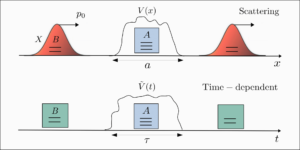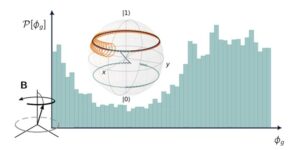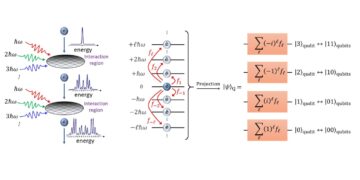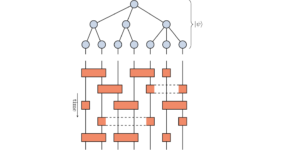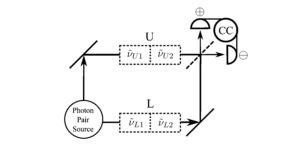
Quantum Research Centre, Technology Innovation Institute, United Arab Emirates.
Departament de Física Quàntica i Astrofísica and Institut de Ciències del Cosmos, Universitat de Barcelona, Spain.
Find this paper interesting or want to discuss? Scite or leave a comment on SciRate.
Abstract
In this article, we present a novel approach to investigating entanglement in the context of quantum computing. Our methodology involves analyzing reduced density matrices at different stages of a quantum algorithm’s execution and representing the dominant eigenvalue and von Neumann entropy on a graph, creating an “entanglement trajectory.” To establish the trajectory’s boundaries, we employ random matrix theory. Through the examination of examples such as quantum adiabatic computation, the Grover algorithm, and the Shor algorithm, we demonstrate that the entanglement trajectory remains within the established boundaries, exhibiting unique characteristics for each example. Moreover, we show that these boundaries and features can be extended to trajectories defined by alternative entropy measures. The entanglement trajectory serves as an invariant property of a quantum system, maintaining consistency across varying situations and definitions of entanglement. Numerical simulations accompanying this research are available via open access.
► BibTeX data
► References
[1] Richard Jozsa and Noah Linden. On the role of entanglement in quantum-computational speed-up. Proceedings of the Royal Society of London. Series A: Mathematical, Physical and Engineering Sciences, DOI: 10.1098/rspa.2002.1097.
https://doi.org/10.1098/rspa.2002.1097
[2] Román Orús and José I Latorre. Universality of entanglement and quantum-computation complexity. Physical Review A, DOI: 10.1103/PhysRevA.69.052308.
https://doi.org/10.1103/PhysRevA.69.052308
[3] Guifré Vidal. Efficient classical simulation of slightly entangled quantum computations. Physical review letters, DOI: 10.1103/PhysRevLett.91.147902.
https://doi.org/10.1103/PhysRevLett.91.147902
[4] David Gross, Steve T Flammia, and Jens Eisert. Most quantum states are too entangled to be useful as computational resources. Physical review letters, DOI: 10.1103/PhysRevLett.102.190501.
https://doi.org/10.1103/PhysRevLett.102.190501
[5] Ingemar Bengtsson and Karol Życzkowski. Geometry of quantum states: an introduction to quantum entanglement. Cambridge University Press, DOI: 10.1017/CBO9780511535048.
https://doi.org/10.1017/CBO9780511535048
[6] Stavros Efthymiou, Sergi Ramos-Calderer, Carlos Bravo-Prieto, Adrián Pérez-Salinas, Diego García-Martín, Artur Garcia-Saez, José Ignacio Latorre, and Stefano Carrazza. Qibo: a framework for quantum simulation with hardware acceleration. Quantum Science and Technology, DOI: 10.1088/2058-9565/ac39f5.
https://doi.org/10.1088/2058-9565/ac39f5
[7] Stavros Efthymiou, Marco Lazzarin, Andrea Pasquale, and Stefano Carrazza. Quantum simulation with just-in-time compilation. Quantum, DOI: 10.22331/q-2022-09-22-814.
https://doi.org/10.22331/q-2022-09-22-814
[8] Ruge Lin. https://github.com/gogoko699/random-density-matrix.
https://github.com/gogoko699/random-density-matrix
[9] Tameem Albash and Daniel A Lidar. Adiabatic quantum computation. Reviews of Modern Physics, DOI: 10.1103/RevModPhys.90.015002.
https://doi.org/10.1103/RevModPhys.90.015002
[10] Neil G Dickson and MHS Amin. Does adiabatic quantum optimization fail for np-complete problems? Physical review letters, DOI: 10.1103/PhysRevLett.106.050502.
https://doi.org/10.1103/PhysRevLett.106.050502
[11] Marko Žnidarič and Martin Horvat. Exponential complexity of an adiabatic algorithm for an np-complete problem. Physical Review A, DOI: 10.1103/PhysRevA.73.022329.
https://doi.org/10.1103/PhysRevA.73.022329
[12] Sergi Ramos-Calderer. https://github.com/qiboteam/qibo/tree/master/examples /adiabatic3sat.
https://github.com/qiboteam/qibo/tree/master/examples/adiabatic3sat
[13] Lov K Grover. A fast quantum mechanical algorithm for database search. Proceedings of the twenty-eighth annual ACM symposium on Theory of computing, DOI: 10.1145/237814.237866.
https://doi.org/10.1145/237814.237866
[14] Sergi Ramos-Calderer. https://github.com/qiboteam/qibo/tree/master/examples /grover3sat.
https://github.com/qiboteam/qibo/tree/master/examples/grover3sat
[15] Alexander M Dalzell, Nicola Pancotti, Earl T Campbell, and Fernando GSL Brandão. Mind the gap: Achieving a super-grover quantum speedup by jumping to the end. Proceedings of the 55th Annual ACM Symposium on Theory of Computing, DOI: 10.1145/3564246.3585203.
https://doi.org/10.1145/3564246.3585203
[16] Thomas Dueholm Hansen, Haim Kaplan, Or Zamir, and Uri Zwick. Faster k-sat algorithms using biased-ppsz. Proceedings of the 51st Annual ACM SIGACT Symposium on Theory of Computing, DOI: 10.1145/3313276.3316359.
https://doi.org/10.1145/3313276.3316359
[17] Sergi Ramos-Calderer, Emanuele Bellini, José I Latorre, Marc Manzano, and Victor Mateu. Quantum search for scaled hash function preimages. Quantum Information Processing, DOI: 10.1007/s11128-021-03118-9.
https://doi.org/10.1007/s11128-021-03118-9
[18] Daniel J Bernstein. Chacha, a variant of salsa20. Workshop record of SASC.
https://cr.yp.to/chacha/chacha-20080120.pdf
[19] Sergi Ramos-Calderer. https://github.com/qiboteam/qibo/tree/master/examples /hash-grover.
https://github.com/qiboteam/qibo/tree/master/examples/hash-grover
[20] Peter W Shor. Polynomial-time algorithms for prime factorization and discrete logarithms on a quantum computer. SIAM review, DOI: 10.1137/S0097539795293172.
https://doi.org/10.1137/S0097539795293172
[21] Vivien M Kendon and William J Munro. Entanglement and its role in Shor’s algorithm. arXiv:quant-ph/0412140.
arXiv:quant-ph/0412140
[22] Sergi Ramos-Calderer. https://github.com/qiboteam/qibo/tree/master/examples/shor.
https://github.com/qiboteam/qibo/tree/master/examples/shor
[23] Robert B Griffiths and Chi-Sheng Niu. Semiclassical Fourier transform for quantum computation. Physical Review Letters, DOI: 10.1103/PhysRevLett.76.3228.
https://doi.org/10.1103/PhysRevLett.76.3228
[24] S Parker and MB Plenio. Entanglement simulations of Shor’s algorithm. Journal of Modern Optics, DOI: 10.1080/09500340110107207.
https://doi.org/10.1080/09500340110107207
[25] Stephane Beauregard. Circuit for Shor’s algorithm using $2n+3$ qubits. arXiv:quant-ph/0205095.
arXiv:quant-ph/0205095
[26] Samuel L Braunstein. Geometry of quantum inference. Physics Letters A, DOI: 10.1016/0375-9601(96)00365-9.
https://doi.org/10.1016/0375-9601(96)00365-9
[27] Hans-Jürgen Sommers and Karol Życzkowski. Statistical properties of random density matrices. Journal of Physics A: Mathematical and General, DOI: 10.1088/0305-4470/37/35/004.
https://doi.org/10.1088/0305-4470/37/35/004
[28] Ion Nechita. Asymptotics of random density matrices. Annales Henri Poincaré, DOI: 10.1007/s00023-007-0345-5.
https://doi.org/10.1007/s00023-007-0345-5
[29] Satya N Majumdar. Extreme eigenvalues of Wishart matrices: application to entangled bipartite system. Oxford Academic, DOI: 10.1093/oxfordhb/9780198744191.013.37.
https://doi.org/10.1093/oxfordhb/9780198744191.013.37
[30] Adina Roxana Feier. Methods of proof in random matrix theory. https://www.math.harvard.edu/media/feier.pdf.
https://www.math.harvard.edu/media/feier.pdf
[31] Giacomo Livan, Marcel Novaes, and Pierpaolo Vivo. Introduction to random matrices theory and practice. Springer Cham, DOI: 10.1007/978-3-319-70885-0.
https://doi.org/10.1007/978-3-319-70885-0
[32] Z D Bai. Methodologies in spectral analysis of large dimensional random matrices, a review. Advances in Statistics, DOI: 10.1142/9789812793096_0015.
https://doi.org/10.1142/9789812793096_0015
[33] Uffe Haagerup and Steen Thorbjørnsen. Random matrices with complex Gaussian entries. Expositiones Mathematicae, DOI: 10.1016/S0723-0869(03)80036-1.
https://doi.org/10.1016/S0723-0869(03)80036-1
[34] Marc Potters and Jean-Philippe Bouchaud. A First Course in Random Matrix Theory: For Physicists, Engineers and Data Scientists. Cambridge University Press, DOI: 10.1017/9781108768900.
https://doi.org/10.1017/9781108768900
[35] Vladimir A Marčenko and Leonid Andreevich Pastur. Distribution of eigenvalues for some sets of random matrices. Mathematics of the USSR-Sbornik, DOI: 10.1070/SM1967v001n04ABEH001994.
https://doi.org/10.1070/SM1967v001n04ABEH001994
[36] John Wishart. The generalised product moment distribution in samples from a normal multivariate population. Biometrika, DOI: 10.1093/biomet/20A.1-2.32.
https://doi.org/10.1093/biomet/20A.1-2.32
[37] Greg W Anderson, Alice Guionnet, and Ofer Zeitouni. An introduction to random matrices. Cambridge University Press, DOI: 10.1017/CBO9780511801334.
https://doi.org/10.1017/CBO9780511801334
[38] Carl D Meyer. Matrix analysis and applied linear algebra. SIAM, DOI: 10.1137/1.9781611977448.
https://doi.org/10.1137/1.9781611977448
[39] G. R. Belitskii , Yurii I. Lyubich. Matrix norms and their applications. Birkhäuser, DOI: 10.1007/978-3-0348-7400-7.
https://doi.org/10.1007/978-3-0348-7400-7
[40] Jean-Phillipe Bouchaud and Marc Potters. Financial applications of random matrix theory: a short review. Oxford Academic, DOI: 10.1093/oxfordhb/9780198744191.013.40.
https://doi.org/10.1093/oxfordhb/9780198744191.013.40
[41] Craig A Tracy and Harold Widom. On orthogonal and symplectic matrix ensembles. Communications in Mathematical Physics, DOI: 10.1007/BF02099545.
https://doi.org/10.1007/BF02099545
[42] Craig A Tracy and Harold Widom. Distribution functions for largest eigenvalues and their applications. arXiv:math-ph/0210034.
arXiv:math-ph/0210034
[43] Iain M Johnstone. On the distribution of the largest eigenvalue in principal components analysis. The Annals of statistics, DOI: 10.1214/aos/1009210544.
https://doi.org/10.1214/aos/1009210544
[44] Marco Chiani. Distribution of the largest eigenvalue for real Wishart and Gaussian random matrices and a simple approximation for the Tracy-Widom distribution. Journal of Multivariate Analysis, DOI: 10.1016/j.jmva.2014.04.002.
https://doi.org/10.1016/j.jmva.2014.04.002
[45] Jinho Baik, Gérard Ben Arous, and Sandrine Péché. Phase transition of the largest eigenvalue for nonnull complex sample covariance matrices. Annals of Probability, DOI: 10.1214/009117905000000233.
https://doi.org/10.1214/009117905000000233
[46] Vinayak and Marko Žnidarič. Subsystem dynamics under random Hamiltonian evolution. Journal of Physics A: Mathematical and Theoretical, DOI: 10.1088/1751-8113/45/12/125204.
https://doi.org/10.1088/1751-8113/45/12/125204
[47] Vinayak and Akhilesh Pandey. Correlated Wishart ensembles and chaotic time series. Physical Review E, DOI: 10.1103/PhysRevE.81.036202.
https://doi.org/10.1103/PhysRevE.81.036202
[48] Vinayak. Spectral density of the noncentral correlated Wishart ensembles. Physical Review E, DOI: 10.1103/PhysRevE.90.042144.
https://doi.org/10.1103/PhysRevE.90.042144
[49] Don N Page. Average entropy of a subsystem. Physical review letters, DOI: 10.1103/PhysRevLett.71.1291.
https://doi.org/10.1103/PhysRevLett.71.1291
[50] Siddhartha Sen. Average entropy of a quantum subsystem. Physical review letters, DOI: 10.1103/PhysRevLett.77.1.
https://doi.org/10.1103/PhysRevLett.77.1
[51] Rajarshi Pal and Arul Lakshminarayan. Probing the randomness of ergodic states: extreme-value statistics in the ergodic and many-body-localized phases. arXiv:2002.00682 [cond-mat.dis-nn].
arXiv:2002.00682
[52] Karol Zyczkowski and Hans-Jürgen Sommers. Induced measures in the space of mixed quantum states. Journal of Physics A: Mathematical and General, DOI: 10.1088/0305-4470/34/35/335.
https://doi.org/10.1088/0305-4470/34/35/335
[53] Patrick Hayden, Debbie W Leung, and Andreas Winter. Aspects of generic entanglement. Communications in mathematical physics, DOI: 10.1007/s00220-006-1535-6.
https://doi.org/10.1007/s00220-006-1535-6
[54] Wolfram Helwig and Wei Cui. Absolutely Maximally Entangled States: Existence and Applications. arXiv:1306.2536 [quant-ph].
arXiv:1306.2536
[55] Dardo Goyeneche, Daniel Alsina, José I Latorre, Arnau Riera, and Karol Życzkowski. Absolutely maximally entangled states, combinatorial designs, and multiunitary matrices. Physical Review A, DOI: 10.1103/PhysRevA.92.032316.
https://doi.org/10.1103/PhysRevA.92.032316
[56] F. Huber and N. Wyderka. Table of AME states. https://tp.nt.uni-siegen.de/ame/ame.html.
https://tp.nt.uni-siegen.de/ame/ame.html
[57] José I Latorre and Germán Sierra. Quantum Computation of Prime Number Functions. arXiv:1302.6245 [quant-ph].
arXiv:1302.6245
[58] José I Latorre and Germán Sierra. There is entanglement in the primes. arXiv:1403.4765 [quant-ph].
arXiv:1403.4765
[59] Diego Garcia-Martin, Eduard Ribas, Stefano Carrazza, José I Latorre, and Germán Sierra. The Prime state and its quantum relatives. Quantum, DOI: 10.22331/q-2020-12-11-371.
https://doi.org/10.22331/q-2020-12-11-371
[60] Murray Rosenblatt. A Central Limit Theorem and a Strong Mixing Condition. Proceedings of the National Academy of Sciences of the United States of America, DOI: 10.1073/pnas.42.1.43.
https://doi.org/10.1073/pnas.42.1.43
[61] Hui Li and F Duncan M Haldane. Entanglement spectrum as a generalization of entanglement entropy: Identification of topological order in non-abelian fractional quantum hall effect states. Physical review letters, DOI: 10.1103/PhysRevLett.101.010504.
https://doi.org/10.1103/PhysRevLett.101.010504
[62] J Ignacio Cirac, Didier Poilblanc, Norbert Schuch, and Frank Verstraete. Entanglement spectrum and boundary theories with projected entangled-pair states. Physical Review B, DOI: 10.1103/PhysRevB.83.245134.
https://doi.org/10.1103/PhysRevB.83.245134
[63] Sudipto Singha Roy, Silvia N Santalla, Javier Rodríguez-Laguna, and Germán Sierra. Bulk-edge correspondence in the Haldane phase of the bilinear-biquadratic spin-$1$ Hamiltonian. Journal of Statistical Mechanics: Theory and Experiment, DOI: 10.1088/1742-5468/abf7b4.
https://doi.org/10.1088/1742-5468/abf7b4
[64] Vincenzo Alba. Entanglement gap, corners, and symmetry breaking. arXiv:2010.00787 [cond-mat.stat-mech].
https://doi.org/10.21468/SciPostPhys.10.3.056
arXiv:2010.00787
[65] Pasquale Calabrese and Alexandre Lefevre. Entanglement spectrum in one-dimensional systems. Physical Review A, DOI: 10.1103/PhysRevA.78.032329.
https://doi.org/10.1103/PhysRevA.78.032329
[66] Andreas M Läuchli, Emil J Bergholtz, Juha Suorsa, and Masudul Haque. Disentangling entanglement spectra of fractional quantum hall states on torus geometries. Physical review letters, DOI: 10.1103/PhysRevLett.104.156404.
https://doi.org/10.1103/PhysRevLett.104.156404
[67] Michael A Nielsen and Isaac Chuang. Quantum Computation and Quantum Information. Cambridge University Press, DOI: 10.1017/CBO9780511976667.
https://doi.org/10.1017/CBO9780511976667
[68] Frank Nielsen and Richard Nock. On Tényi and Tsallis entropies and divergences for exponential families. arXiv:1105.3259 [cs.IT].
https://doi.org/10.1088/1751-8113/45/3/032003
arXiv:1105.3259
Cited by
Could not fetch Crossref cited-by data during last attempt 2024-03-14 11:58:50: Could not fetch cited-by data for 10.22331/q-2024-03-14-1282 from Crossref. This is normal if the DOI was registered recently. On SAO/NASA ADS no data on citing works was found (last attempt 2024-03-14 11:58:51).
This Paper is published in Quantum under the Creative Commons Attribution 4.0 International (CC BY 4.0) license. Copyright remains with the original copyright holders such as the authors or their institutions.
- SEO Powered Content & PR Distribution. Get Amplified Today.
- PlatoData.Network Vertical Generative Ai. Empower Yourself. Access Here.
- PlatoAiStream. Web3 Intelligence. Knowledge Amplified. Access Here.
- PlatoESG. Carbon, CleanTech, Energy, Environment, Solar, Waste Management. Access Here.
- PlatoHealth. Biotech and Clinical Trials Intelligence. Access Here.
- Source: https://quantum-journal.org/papers/q-2024-03-14-1282/
- :is
- :not
- 056
- 1
- 10
- 11
- 12
- 13
- 14
- 15%
- 16
- 17
- 19
- 20
- 2014
- 22
- 23
- 24
- 25
- 26%
- 27
- 28
- 29
- 30
- 31
- 32
- 33
- 35%
- 36
- 39
- 40
- 41
- 43
- 49
- 50
- 51
- 54
- 58
- 60
- 65
- 66
- 67
- 7
- 77
- 8
- 9
- 91
- a
- absolutely
- ABSTRACT
- academic
- Academy
- acceleration
- access
- achieving
- ACM
- across
- advances
- affiliations
- Alexander
- algorithm
- algorithms
- alice
- alternative
- america
- an
- analysis
- analyzing
- and
- anderson
- annual
- Application
- applications
- applied
- approach
- Arab
- Arab Emirates
- ARE
- article
- AS
- aspects
- At
- attempt
- author
- authors
- available
- average
- barcelona
- BE
- ben
- Bernstein
- boundaries
- boundary
- Break
- Breaking
- by
- cambridge
- campbell
- CAN
- Carl
- carlos
- central
- centre
- characteristics
- comment
- Commons
- Communications
- complex
- complexity
- components
- computation
- computational
- computations
- computer
- computing
- condition
- context
- copyright
- corners
- Cosmos
- could
- Course
- Craig
- Creating
- Daniel
- data
- Database
- David
- de
- Debbie
- defined
- definitions
- del
- demonstrate
- designs
- Diego
- different
- discuss
- distribution
- does
- dominant
- don
- duncan
- during
- dynamics
- e
- each
- effect
- efficient
- emil
- emirates
- end
- Engineering
- Engineers
- entanglement
- establish
- established
- evolution
- examination
- example
- examples
- execution
- Exhibiting
- existence
- experiment
- exponential
- extended
- extreme
- FAIL
- families
- FAST
- faster
- Features
- financial
- First
- For
- found
- fractional
- Framework
- frank
- from
- function
- functions
- gap
- General
- GitHub
- graph
- gross
- Grover
- Hall
- Hardware
- harold
- harvard
- hash
- holders
- HTML
- HTTPS
- i
- Identification
- if
- in
- information
- Innovation
- Institute
- institutions
- interesting
- International
- Introduction
- investigating
- involves
- IT
- ITS
- JavaScript
- John
- journal
- large
- largest
- Last
- Leave
- Li
- License
- LIMIT
- lin
- linear
- London
- Maintaining
- mar
- Marco
- Martin
- math
- mathematical
- mathematics
- Matrix
- measures
- mechanical
- mechanics
- methodologies
- Methodology
- methods
- Meyer
- Michael
- mind
- Mind The Gap
- mixed
- Mixing
- Modern
- moment
- Month
- Moreover
- most
- Murray
- National
- no
- Noah
- nock
- normal
- norms
- novel
- nt
- number
- of
- on
- open
- optics
- optimization
- or
- order
- original
- our
- Oxford
- page
- pages
- Paper
- patrick
- Peter
- phase
- phases
- physical
- Physics
- plato
- Plato Data Intelligence
- PlatoData
- population
- practice
- present
- press
- Prime
- Principal
- Problem
- problems
- Proceedings
- processing
- Product
- projected
- proof
- properties
- property
- published
- publisher
- Quantum
- Quantum Computer
- quantum computing
- quantum entanglement
- quantum information
- qubits
- R
- random
- randomness
- real
- recently
- record
- Reduced
- references
- registered
- relatives
- remains
- representing
- research
- Resources
- review
- Reviews
- Richard
- ROBERT
- Role
- roy
- royal
- s
- sample
- scaled
- Science
- Science and Technology
- SCIENCES
- scientists
- Search
- Series
- Series A
- serves
- Sets
- Shor
- Shor algorithm
- Short
- show
- siam
- silvia
- Simple
- simulation
- simulations
- situations
- Society
- some
- Space
- Spain
- Spectral
- Spectrum
- stages
- State
- States
- statistical
- statistics
- Steve
- strong
- such
- Symposium
- system
- Systems
- table
- Technology
- Technology Innovation
- that
- The
- their
- theoretical
- theory
- There.
- These
- this
- thomas
- Through
- time
- Time Series
- Title
- to
- too
- tracy
- trajectory
- Transform
- transition
- under
- unique
- United
- United Arab
- United Arab Emirates
- United States
- UNITED STATES OF AMERICA
- university
- URL
- useful
- using
- Variant
- varying
- via
- volume
- von
- W
- want
- was
- we
- william
- Winter
- with
- within
- works
- workshop
- year
- zephyrnet



